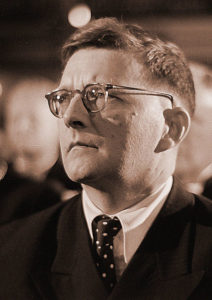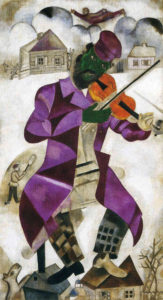When Shostakovich began composing his First Violin Concerto in 1947, he was enjoying a period of relative calm. World War II had distracted Stalin’s government from show trials and purges, leaving artists slightly less harassed than usual. In 1942, Shostakovich unveiled his Leningrad Symphony, which won a Stalin Prize and was played across the allied world as a symbol of solidarity in the fight against the Nazis. A number of other official plaudits followed, and in 1947 Stalin ordered that the Shostakovich family be given a nicer apartment and a dacha in the countryside.

Alas, by the time Shostakovich completed the violin concerto in 1948, the situation had changed completely. Having defeated the enemy without, the Soviet government soon resumed its incessant witch hunts for enemies within. In the arts, literature was the first target after the war, but by 1948 it was music’s turn. With little warning, Shostakovich and other leading Soviet composers found that many of their works that were once praised were now banned. The rationales given were ludicrous; Shostakovich and other composers were forced to listen to long harangues from cultural apparatchiks laden with virtually meaningless terms like “formalism” and “socialist realism.” Despite having sincerely tried to understand these terms for the past two decades, many composers came to the conclusion that social realist works were simply the ones in favor at the moment and formalist ones were not. It would have been laughable if only so much had not been at stake.
Shostakovich finished his violin concerto anyway, although it would not be premiered until after Stalin’s death in 1955 (the violinist for the premiere would be the great David Oistrakh, featured below. Shostakovich dedicated the concerto to him). This was not the first time such things had happened, nor would it be the last. The concerto he wrote took the suffering of his absurd and treacherous world and transmuted it into something beautiful and profound.
The Music
Shostakovich at this time had become increasingly interested in baroque musical forms. Perhaps in emulation of some baroque concertos, Shostakovich wrote his violin concerto in four movements organized slow-fast-slow-fast instead of following the usual three-movement pattern, fast-slow-fast. The opening Nocturne is a somber, meditative soliloquy for the soloist, accompanied by dark-hued orchestral timbres:
After this introspective night music, the ensuing scherzo is a wild, frenetic dance. In this movement, Shostakovich introduces for the first time what would become his musical signature: the notes D-Eb-C-B (in German, these notes are called D-S-C-H, a cypher for Dmitri SCHostokowitsch, the German spelling of Shostakovich’s name).
Technically, the first appearance of this figure is D#-E-C#-B, but it later morphs into the more usual form. The inclusion of this motif suggests an autobiographical intent. We cannot know what Shostakovich was thinking when he wrote this passage, but one of Shostakovich’s comments to his friend Maria Sabinina after being forced to read a speech at this time seems to resonate:
“And I got up on the tribune, and started to read out aloud this idiotic, disgusting nonsense concocted by some nobody. Yes, I humiliated myself, I read out what was taken to be ‘my own speech.’ I read like the most paltry wretch, a parasite, a cut-out paper doll on a string!!” This last phrase he shrieked out like a frenzied maniac, and then kept on repeating it.

Not long after the appearance of Shostakovich’s musical signature, the music arrives at a boisterous, klezmer-inspired central episode.
Though not Jewish himself, Shostakovich noted that “My parents considered anti-Semitism a shameful superstition, and in that sense particularly I was given a very good upbringing.” Unfortunately, not all Soviets were so enlightened. Becoming increasingly paranoid, Stalin had begun an anti-Semitic campaign during WWII which intensified in 1948. Regarding the persecution, Shostakovich remarked “…how ‘this’ had started with the Jews but would end up with the entire intelligentsia.” The revelations of the atrocities of the holocaust further fueled Shostakovich’s interest in Jewish music. His inclusion of klezmer-inspired music in this concerto and a number of other works that followed may have been another veiled protest against the regime.
The third movement is a passacaglia, a type of baroque theme and variations in which a bass line is repeated as new melodies and textures are introduced above it. The bass line in this case is a heavy, oppressive figure introduced by the cellos and basses, as horns play pulsing figures and arpeggios above it. After a quieter variation for winds, the soloist enters with an expressive melody. An increasingly tense series of variations follows, until the solo violin takes up the bass line itself before returning to its original melody. The following variation features chant-like repeated notes reminiscent of the elegy from Tchaikovsky’s Third String Quartet.
This mournful music fades seamlessly into the cadenza, an extended passage for the soloist unaccompanied by the orchestra. In the concertos of the previous century, cadenzas were normally placed just before the end or at the climax of the first movement. Instead, Shostakovich places his cadenza between movements, making it seem untethered, as if we have passed into some netherworld that is neither here nor there. Suspended in this liminal space, the soloist seems even more alone and isolated. The cadenza becomes faster and more intense as it progresses, recalling ideas from the previous movements, including the DSCH motif. Climaxing with the return of the klezmer theme in the violin’s highest register, the cadenza then accelerates into the finale.
Shostakovich titled the last movement “burlesca,” an indication that fits the music’s darkly comic atmosphere. Its mad, virtuoso fiddle music brings the concerto to an unsettling, but thrilling conclusion. –Calvin Dotsey
Don’t miss Shostakovich’s Violin Concerto No. 1 this Thanksgiving weekend, November 24, 25 & 26, 2017! For tickets and more information, visit houstonsymphony.org.




One response to “Fiddler on the Roof? A Guide to Shostakovich’s Violin Concerto No. 1”